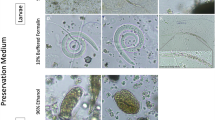Abstract
SEVERAL specimens of Calotes versicolor (a garden lizard) were collected from gardens in Guindy near Madras, during March 1949. Blood, exuding from their cut tails, was examined for filarial infection. Six calotes found positive with microfilariæ of C. guindiensis were killed by the use of chloroform. Before preservation in formol–saline (one part of commercial formalin to four parts of normal saline) a 2-in. slit was made in the abdominal wall to open it. The specimens were brought to Delhi for demonstrating the adult worms in situ. In one specimen, which was dissected fourteen days later, although some degree of putrefaction had taken place, viable filarial worms were seen. Some of the adult female worms contained ova which stretched out to typical microfilarial forms. Similar findings were observed in the remaining calotes dissected at weekly intervals. The last two calotes were dissected in the sixth week of preservation. Temperature during that period ranged from 97.0°F. maximum to 51.0°F. minimum.
This is a preview of subscription content, access via your institution
Access options
Subscribe to this journal
Receive 51 print issues and online access
$199.00 per year
only $3.90 per issue
Buy this article
- Purchase on Springer Link
- Instant access to full article PDF
Prices may be subject to local taxes which are calculated during checkout
Similar content being viewed by others
Author information
Authors and Affiliations
Rights and permissions
About this article
Cite this article
RAGHAVAN, N. Viability of Conispiculum guindiensis in Calotes versicolor Preserved in Formalin. Nature 170, 125–126 (1952). https://doi.org/10.1038/170125b0
Issue Date:
DOI: https://doi.org/10.1038/170125b0
Comments
By submitting a comment you agree to abide by our Terms and Community Guidelines. If you find something abusive or that does not comply with our terms or guidelines please flag it as inappropriate.



